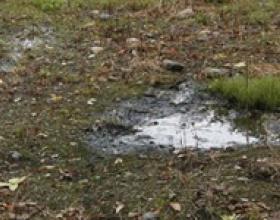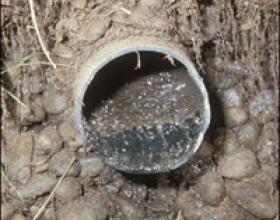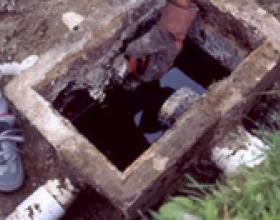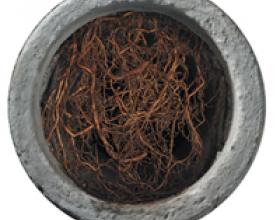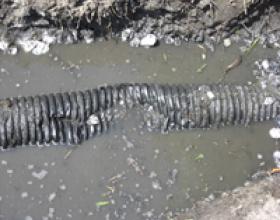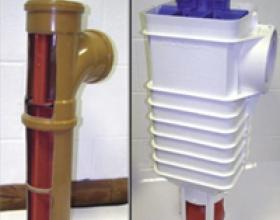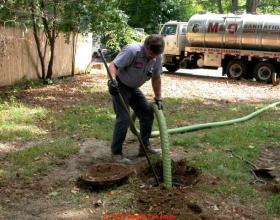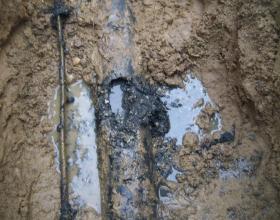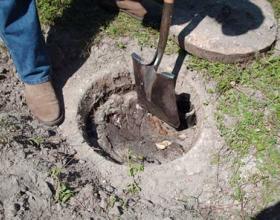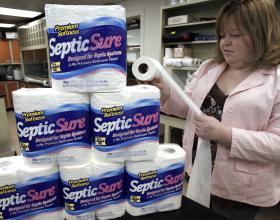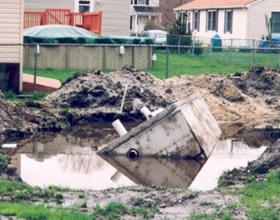Pacific Group Developments wants to help educate our clients about the maintenance, process, parts, installation and assembly of septic systems. This page is designed to help you understand what you need to know about maintaining your septic tank and septic system.
Proper Maintenance of your Septic Tank
Inspect your septic tank annually and pump it when needed or every two years. If the tank is not pumped periodically, solids escaping from the septic tank will clog the pump and drain field.
Avoid flushing harmful material into the septic tank. Never put grease, newspapers, paper towels, cigarettes, coffee grounds, sanitary napkins, solvents, oils, paint or pesticides into the tank.
Avoid using any chemical or biological septic tank additive. Additives do not improve the performance of the tank. They do not reduce the need for routine pumping, and some are even harmful to the system.
Pumping your Tank
- Pacific Group Developments is here to meet all of your maintenance needs. We take care and every precaution when pumping out tanks during wet periods when soils are saturated. Partially empty tanks may float out of the ground unless precautions are taken to hold them down.
- We make sure pumping is done through the large manhole, located centrally on the tank. Under no circumstances should the baffle inspection ports or outlet to the drain field be used for pumping out the tank. Pumping through the baffle inspection port can damage the baffles and deteriorate the absorption properties of the drain field. During the pumping process, stop and check if there’s a reverse flow of sewage to septic tank. This may be the case if the drain field is severely clogged and has a compromised absorption of the drain field.
- We install risers from the central manhole and inspection ports up to the soil surface if they’re not already installed.
- Once the pumping process is complete, it’s important to wash the inside of the tank to facilitate a complete inspection. A garden hose is perfect for this task. After cleaning, the tank should be checked for leaks and if any are found we will take the necessary steps to ensure they are sealed.
Proper Maintenance of your Pump and Pump Chamber
The pump chamber collects the septic tank effluent. The chamber contains a pump, as well as pump control floats and a high-water alarm float.
The control floats are adjustable and are set for pumping a specific volume of effluent. The high-water alarm float in the pump chamber starts an alarm to warn you of any pump or system malfunction. The alarm should consist of a buzzer and an easily visible light.
Checklist – Pump and Pump Chamber
- Check the pump chamber, pump and floats every year. Replace or repair as needed. Pump maintenance should follow the manufacturer’s recommendations.
- Electrical parts and conduits should be checked for corrosion. If the alarm panel has a push-to-test button, go ahead and check it regularly.
- Installing a septic tank effluent filter or pump screen (if your system doesn’t already have one) prevents solids from clogging the pump and drain field pipes. Inspecting a screen or filter, and clearing when necessary, are quick and easy steps and highly recommended as they prevent costly damage from solids entering the system.
- Be aware of drain field overloading after lengthy power failures or pump failure. Effluent will continue to accumulate in the pump chamber until the pump resumes operation. When power is restored or the pump resumes operation, it will pump until the tank is empty, possibly pumping a volume greater than the drain field can handle. Also, if all of the reserve storage within the chamber is used, the plumbing in your home can back up. When the pump is off for more than six hours, take the following steps to help protect the drain field:
- Reduce your water use to a minimum
- Turn off the pump at the control panel
- Once power is restored or the pump is repaired, switch the pump on and let it run for a maximum of five minutes before turning it off again. Repeat the manual operation every six hours until the effluent drops to the off level and the float turns off automatically.
Maintenance of the Septic Field
The drain field is made of a network of pipes laid in gravel-filled trenches as much as a metre wide or in gravel beds. Effluent from the septic tank is pumped through pipes to the septic field, where the liquid drains slowly and evenly through perforations in the pipes. The liquid percolates through the gravel and eventually reaches the soil beneath, which filters it before the liquid reaches the water table.
Most new drain fields are required to have a designated replacement area. It must be maintained should the existing system need an addition or repair.
Checklist – Septic Field
- Know where the system and replacement area are located and protect them. Avoid building or landscaping over top of your system and prevent vehicles from driving over it. Don’t plant trees or shrubs too close to your field or tank. Roots can cause damage and clog your drain field.
- Practice water conservation and balance your water use throughout the week to keep from overloading the system. The more wastewater you produce, the more the soil must treat and dispose of.
- Divert water from surfaces such as roofs, driveways or patios away from the septic field and replacement area. Soil laid over the system should be mounded, or slightly raised, to facilitate water runoff.
- Do not drive over septic system components including septic piping or septic drain fields unless the components are specifically rated to bear the weight of a vehicle. Doing so can cause significant damage. Septic components buried under a driveway might not be damaged until a heavy vehicle drives on them. This means a homeowner can spend considerable time without any trouble, and then have their system collapse under the weight of a heavy vehicle.
What to do if the Alarm Switches on?
Once the water level rises high enough inside the septic pump chamber to reach the alarm float, the alarm light and buzzer will start. There could be a number of causes for the alarm to trigger, which we’ll explore in a moment.
If the alarm does trigger, use water very conservatively. Avoid bathing, showering or doing the laundry because without large influxes of wastewater there’s enough reserve storage in the pump chamber to allow you enough time to get the problem corrected.
To silence the alarm, push the reset button on the alarm panel. Before calling for service or repair follow this checklist:
Checklist – alarm
- A tripped circuit breaker: The pump should have its own circuit and breaker. If it’s on a circuit with other equipment, that equipment can cause the breaker to trip.
- A pump or float switch power chord has become unplugged: If the connections are of the plug variety, make sure they have good contact in the sockets.
- Control floats tangled by other parts in the chamber such as electric power chord, lifting rope or pump screen: Make sure that floats operate freely in the chamber.
- Debris on floats or support cable that is causing to the pump to switch off. Lift the floats out of the chamber and clean them.
Warning! Make sure the power supply is turned off at the circuit breaker and unplug all power chords before handling the pump or floats.
Warning! Do not enter the pump chamber. The gases contained inside the chamber are poisonous and the lack of oxygen can be fatal.
If the problem can’t be resolved by following the above steps call us for assistance.
The facts on laundry
Laundry loads should be spread out over the week. Excessive water discharged into the septic system is known as hydraulic overload. Too much water dumped into the system is the number-one killer of septic fields.
Bleach loads should be limited to one day per week. One cup of bleach in a 4,000-litre tank can kill 80% of the beneficial bacteria for up to 72 hours. So doing all the bleaching at once gives the tank adequate recovery time.
Things to Avoid Dumping in the Tank
Avoid additives sold or advertised for septic systems. They do more harm for the drain field than good for the tank. Also avoid flushing grease, fats, oils, pesticides, herbicidesand anytoxins, such aspaints, household chemicals orautomobile fluids. Also avoid flushing citrus products, such as oranges, lemon and grapefruits. Non-biodegradable items such as cigarette butts, disposable diapers, baby wipes, toilet cleaning wipes, feminine hygiene products, condoms, hair, coffee grounds, rags, paper towels andbandages should also be kept out of the septic system.
Additionally, avoid dumping home brewery waste. Antibacterial soaps andwipes should be used sparingly and whenever possible disposed of outside of the system. Avoid strong medicines (especially antibiotics) in human waste or dumped directly into the system. Use fabric softener sheets in the dryer, rather than liquids in the wash. Also, avoid dumping strong cleaning chemicals, such as Lysol, Pine Sol, Tidy Bowl, Drano and Murphy’s Oil.
Garbage Disposal and Septic Systems
If you have a garbage disposal, use it sparingly. Put food waste and grease into the solid waste bin or compost. Food waste causes additional loading of the tank, increasing the need for pumping.
Other Septic Tank Killers
- Water conditioning equipment going through the septic tank may harm bacteria growth within the septic tank and harm the tank itself and may shorten the life of the absorption facility in certain clay-type soils.
- Metal septic tanks will corrode and ruin the leach field. There is no warning for when the tank will eventually deteriorate. Once the tank does go the entire septic system must be replaced (including drain fields), which can be extremely costly to repair.
- High seasonal groundwater (high groundwater normally occurs in the spring).
Addressing a Septic System Failure
All septic systems have a limited life expectancy so one can expect that they will fail at some point in time.
Failing systems can expose you, your family and neighbours to sewage. Sewage contains pathogens and viruses that can cause disease. Sewage can also contaminate ground and surface water possibly polluting wells, streams, rivers or lakes near your home.
Signs that your septic system is failing:
- Dark-green grass over leach field area.
- A septic odor
- Back-up in the house or gurgling noise/slow flush.
- Septic water surfacing in the yard.
- Sludge on top of baffles in septic tank.
If you’re experiencing any of the above symptoms, give us a call. We’re here to help.
Make sure the septic system has safe and secure covers.
Any movement of the tank, tank cover or distribution box, or of areas of the drain field, which is called settlement, can mean that components have become tipped or possibly disconnected.
Any unwanted water draining onto the septic tank, the tank’s lid, distribution box or drain field, such as rain runoff, can significantly shorten the life of the drain field.
Soil test: It might be a good idea to do a soil perc test to see if the soil still drains as well as was claimed when the septic drain field was built.

